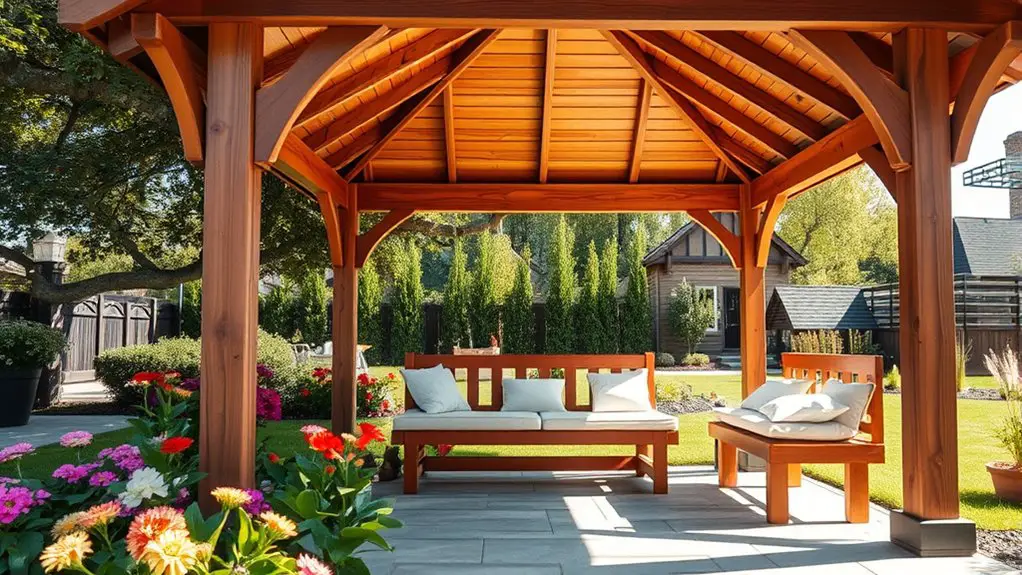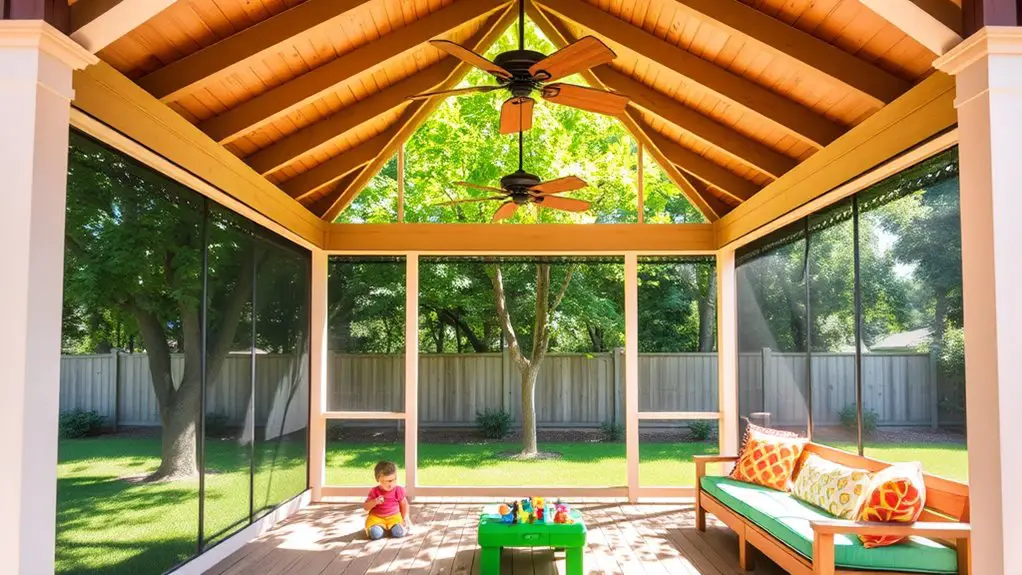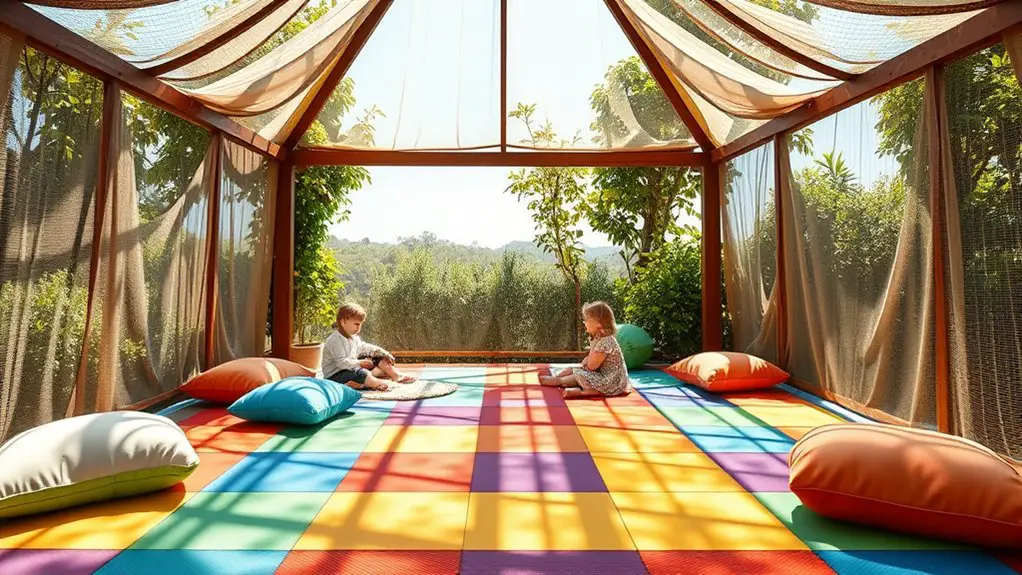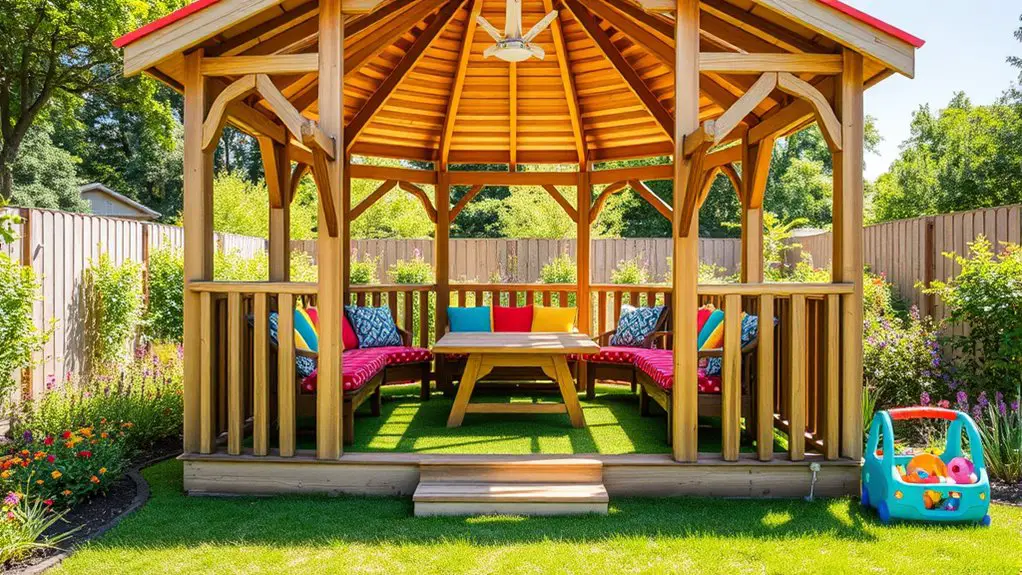To create a child-friendly gazebo, choose safe materials like untreated wood and low-VOC finishes. Design a sturdy structure with rounded edges and non-slip surfaces. Incorporate features like lockable gates and ventilation screens to keep kids safe and comfortable. Select durable, cushioned flooring and arrange child-friendly furniture in defined play areas. Regularly inspect for hazards and maintain stability. For additional insights and detailed design strategies, keep exploring different safety elements and features.
Choosing Safe Materials for Your Gazebo

When it comes to choosing safe materials for your gazebo, you’ll want to prioritize options that minimize risks for children. Opt for eco-friendly options like sustainably sourced wood or bamboo, which not only blend seamlessly into nature but also provide a sturdy structure. Avoid pressure-treated lumber that can leach harmful chemicals; instead, choose untreated wood that’s been finished with non-toxic treatments to guarantee a safe play environment.
For roofing, consider using recycled materials or metal, as they’re durable and won’t harbor mold or other allergens. If you’re using paint or sealants, make sure they’re low-VOC or VOC-free, protecting your kids from potential toxins. Additionally, ensure that the materials selected offer long-lasting strength, contributing to a safe and secure environment for children’s activities.
Lastly, always check for sharp edges or splinters, guaranteeing every corner is child-friendly. By carefully selecting materials, you’re creating a sanctuary where children can explore and play freely without the worry of harmful substances.
Designing a Secure Structure
When designing a secure structure for your gazebo, it’s essential to choose sturdy materials that withstand the elements and daily wear. Proper ground anchoring guarantees stability, preventing any accidental tipping or movement. Incorporating safe design features, like rounded edges and non-slip surfaces, can further protect your little ones while they enjoy their outdoor space. Additionally, ensuring that the gazebo is anchored to pavers can significantly enhance its stability against strong winds and other weather conditions.
Sturdy Materials Selection
Selecting sturdy materials for your gazebo is essential for creating a safe and secure structure that withstands the test of time and play. Opt for materials that are not only durable but also child-friendly. Here’s a quick guide to help you choose wisely:
- Weather resistant materials: Choose rot-resistant wood or synthetic options that can endure the elements.
- Non-toxic finishes: Confirm any sealants or paints are free from harmful chemicals, keeping your space safe for little ones.
- Heavy-duty hardware: Use robust hinges and fasteners to maintain structural integrity.
- Composite decking: Consider slip-resistant surfaces for safety during play, reducing the risk of accidents.
Proper Ground Anchoring
To guarantee your gazebo remains stable and secure, proper ground anchoring is essential, especially in areas prone to strong winds or shifting soil. Start by evaluating your site’s ground stability; different soil types necessitate varied anchoring methods. Use concrete footings for solid support in sandy or loose soils, while ground screws or stakes work well for firmer grounds. Follow safety guidelines by ensuring anchors are deep enough to resist overturning during storms. Regularly check the integrity of your anchors, as soil erosion can compromise stability over time. By investing time in thorough anchoring, you’ll create a haven where kids can play freely, knowing the structure stands strong against nature’s elements. Your gazebo will be a safe retreat for family and friends.
Safe Design Features
While designing a secure structure for your gazebo, incorporating child-friendly features can considerably enhance safety and peace of mind. By prioritizing these elements, you make certain your space is both functional and inviting for little ones. Here are some essential safety features to take into account for a child-friendly design:
- Rounded Edges: Make sure all surfaces are smooth to prevent injuries.
- Non-Slip Flooring: Opt for materials that provide grip, reducing the risk of slips.
- Secure Railings: Install sturdy railings around elevated areas to keep children safe.
- Ventilation Screens: Use screens to keep bugs out while allowing airflow, making certain a comfortable environment.
With these safety features, your gazebo can be a haven for family fun while keeping the little ones secure.
Incorporating Safety Features
When designing a child-friendly gazebo, prioritizing safety features is essential for ensuring a secure environment. Start by selecting materials that are non-toxic and splinter-free. Consider rounded edges on furniture and railings to minimize injury risks. Installing sturdy, lockable gates can prevent unsupervised access, enhancing child supervision.
For added safety, integrate an emergency preparedness kit within the gazebo. This should include first aid supplies, flashlights, and a whistle for signaling in case of emergencies. You might also want to have clear, visible emergency contact numbers displayed. Additionally, consider incorporating anchoring solutions to keep gazebo curtains secure and prevent potential hazards from flapping fabric.
Incorporating soft, weather-resistant flooring can cushion falls while facilitating easy cleanup. Finally, opt for sturdy, adjustable shade covers to protect children from harmful UV rays, allowing them to play freely. By implementing these safety features, you’ll create a haven where kids can explore, play, and thrive without compromising their well-being.
Ensuring Proper Ventilation

When designing your child-friendly gazebo, ensuring proper ventilation is essential for comfort and safety. Consider airflow design, like strategic openings and elevated ceilings, to promote a revitalizing breeze. Additionally, installing screens can keep bugs out while balancing shade and sunlight for a pleasant atmosphere. Incorporating a gazebo ceiling fan can further enhance airflow and comfort, making the space more enjoyable for children and adults alike.
Airflow Design Considerations
To guarantee a comfortable environment in your gazebo, it is crucial to prioritize airflow design considerations for proper ventilation. Understanding airflow dynamics helps you create a space that feels open and breezy, ensuring your children can play safely and comfortably.
Consider these ventilation methods:
- Strategic Placement of Openings: Position windows and vents to catch natural breezes.
- Ventilation Fans: Use ceiling or portable fans to enhance air circulation.
- Roof Design: Opt for a sloped roof to promote hot air escape and improve airflow.
- Material Choice: Select breathable materials for walls and flooring to encourage airflow.
Use of Screens
Incorporating screens into your gazebo design not only adds aesthetic appeal but also plays an essential role in ensuring proper ventilation. Choosing the right screen types, like retractable or fixed screens, can enhance airflow while keeping pests at bay. These screens create a barrier without sacrificing the openness you desire.
The benefits of screens extend beyond comfort; they help regulate temperature and humidity levels, making your gazebo a more enjoyable space for your family. Plus, with various materials available, you can find options that blend seamlessly with your design. Ultimately, by prioritizing screens, you’re not just enhancing safety—you’re creating a breezy, inviting atmosphere where your children can play freely while staying protected.
Shade and Sunlight Balance
While screens are effective for keeping pests out and improving airflow, achieving the right balance of shade and sunlight in your gazebo is essential for creating a comfortable environment. You’ll want to contemplate various shading options to minimize excessive sun exposure while allowing for invigorating breezes. Here are some ways to guarantee proper ventilation:
- Adjustable Canopies: Install retractable awnings for customizable sun coverage.
- Lattice Panels: Use trellises with climbing plants to diffuse sunlight naturally.
- Umbrellas: Incorporate large umbrellas for portable and flexible shade solutions.
- Cross Ventilation: Position the gazebo to capture natural breezes, enhancing airflow.
Selecting Appropriate Flooring

Selecting the right flooring for your gazebo can greatly enhance both safety and comfort for children. You’ll want to contemplate materials that provide a soft landing for those inevitable tumbles. Eco-friendly options like bamboo or reclaimed wood not only look great but are also sustainable choices that promote a healthy environment.
Cushioning alternatives, such as rubber tiles or foam mats, can transform your gazebo into a safer play area. These surfaces absorb impact, reducing the risk of injury while still allowing for ease of maintenance. Additionally, consider slip-resistance features, which are crucial for preventing accidents during play, especially in wet conditions.
When choosing, think about drainage and slip resistance, especially if your gazebo is exposed to rain. Textured surfaces can help prevent slips, adding an extra layer of safety. Ultimately, the right flooring can create a welcoming space where kids can play freely while you enjoy peace of mind.
Adding Child-Friendly Furniture
To create a truly inviting and safe environment in your gazebo, you should consider the type of furniture you add, as it can greatly impact how children interact with the space. Opting for child-sized tables and colorful seating can enhance both safety and enjoyment. Here are some tips to keep in mind:
- Choose durable materials: Select weather-resistant furniture that can withstand the elements.
- Incorporate bright colors: Colorful seating not only attracts kids but also makes the space feel lively and fun.
- Ensure stability: Make sure tables and chairs are sturdy to prevent tipping during play.
- Opt for soft surfaces: Consider cushions or padded seating to create a comfortable and safe area for kids. Additionally, selecting furniture that complements the gazebo’s overall aesthetic can enhance the visual appeal of your outdoor space.
Creating Defined Play Areas
Creating defined play areas in your gazebo not only enhances safety but also encourages imaginative play and exploration among children. By designating specific zones for various activities, you foster a sense of organization and freedom for their creativity. Additionally, having a gazebo can create shaded areas that promote outdoor activities while ensuring children are protected from the elements.
| Play Zone | Activity Areas | Safety Features |
|---|---|---|
| Arts & Crafts | Drawing, Painting | Non-toxic materials |
| Reading Corner | Books, Storytime | Soft seating |
| Outdoor Games | Mini Sports | Soft grass or mats |
Consider using rugs or mats to visually separate these play zones while providing comfort. Incorporating storage solutions for toys can help keep the space tidy and inviting. With these defined areas in place, children can engage in their chosen activities without distractions, allowing for a safe and enjoyable experience in your gazebo.
Installing Safety Barriers
When installing safety barriers around your gazebo, it’s essential to choose materials that are both durable and child-friendly, ensuring they can withstand wear and tear while keeping little ones safe. Make sure to secure all entrance points effectively, preventing accidental exits and keeping your children within sight. By focusing on these elements, you create a secure environment that enhances playtime enjoyment. Additionally, using strong and durable materials for the barriers can help withstand adverse weather conditions, ensuring long-lasting safety.
Choose Appropriate Materials
Choosing the right materials for installing safety barriers around your gazebo is essential to guaranteeing a secure environment for children. You’ll want to select options that not only protect but also align with your values. Here are some materials to take into account:
- Eco-friendly options: Bamboo or recycled wood minimize environmental impact.
- Weather-resistant materials: Composite fencing can endure the elements, maintaining safety year-round.
- Soft barriers: Mesh netting or padded panels provide protection while allowing visibility.
- Non-toxic finishes: Verify any coatings or paints are child-safe to prevent harmful exposure.
Secure Entrance Points
To guarantee that your gazebo remains a safe haven for children, securing entrance points with effective safety barriers is essential. Start by installing gated entrances that offer easy access while preventing unwanted exits. Choose gates with secure locks that are childproof yet easily operable for adults. Opt for designs that blend seamlessly with your gazebo’s aesthetics while emphasizing durability and safety. Consider using self-closing mechanisms, ensuring gates close automatically after use. This minimizes the risk of children wandering off or entering without supervision. Additionally, maintain clear visibility around the entrance area, so you can easily monitor activity. By prioritizing secure entrance points, you can create a welcoming space that encourages freedom while keeping safety at the forefront.
Planning for Shade and Sun Protection
As you plan your gazebo, considering shade and sun protection is essential for creating a safe and enjoyable environment for children. Understanding sunlight angles can help you position your gazebo for peak coverage throughout the day. Incorporate various shade structures to guarantee that kids can play comfortably without direct sun exposure.
- Retractable awnings: Adjustable options let you control shade levels based on the time of day.
- Pergolas with climbing vines: Provide natural shade, while enhancing the aesthetic appeal.
- Canopies or umbrellas: Portable solutions that can be moved as needed for flexible sun protection.
- Natural shade from trees: Strategically place your gazebo near existing trees for added cover. Additionally, consider using materials that block harmful UV rays to enhance the safety of your gazebo.
Regular Maintenance and Inspections
While it might be easy to overlook, regular maintenance and inspections are essential for ensuring your gazebo remains a safe and inviting space for children. Start by checking for any signs of wear and tear, such as loose boards or rusted hardware. Schedule ongoing maintenance tasks, like sealing wood to prevent rot and treating metal to avoid corrosion.
Regular inspections should include evaluating the structural integrity of your gazebo, ensuring that railings are secure, and that there are no sharp edges. Don’t forget to inspect the roof for leaks, as water damage can compromise safety. Additionally, be sure to check for insect infestations as they can pose risks to children playing in the gazebo.
Consider creating a checklist to track your maintenance activities, ensuring nothing is missed. By dedicating time to these tasks, you not only enhance the longevity of your gazebo but also create a worry-free environment where your kids can play freely and safely.
Frequently Asked Questions
What Age Group Is Best Suited for a Child-Friendly Gazebo?
The best age group for a child-friendly gazebo spans toddlers to teens. While toddlers enjoy safe play areas, teens benefit from a hangout space, fostering creativity and freedom in a versatile, secure outdoor environment.
Can I Include Electric Features in a Child-Friendly Gazebo?
You can definitely include electric features in your gazebo, but prioritize electric safety. Opt for child-safe lighting options, ensuring they’re properly installed and out of reach, allowing your kids to enjoy the space worry-free.
How Can I Personalize the Gazebo for My Child’S Interests?
Your gazebo can become a vibrant canvas; incorporate themed decorations reflecting your child’s passions. Design activity zones for crafts or games, letting their interests flourish. This personalized touch creates a magical retreat they’ll cherish.
Are There Any Specific Plants to Avoid Near a Child-Friendly Gazebo?
When landscaping around your gazebo, steer clear of toxic plants like oleander and foxglove. Instead, opt for safe landscaping options, such as lavender and marigolds, ensuring your child’s play area remains both beautiful and secure.
How Do I Teach Children Gazebo Safety Rules?
To teach children gazebo safety rules, conduct safety demonstrations regularly and incorporate rule reminders during play. Encourage questions, fostering understanding, while allowing them to explore safely. Empower their curiosity with structured guidance for a fun experience.

